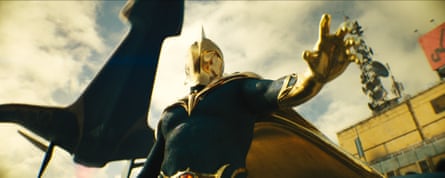Dwayne Johnson is here to claim his throne as Hollywood’s greatest action hero, and Black Adam seems like the perfect vehicle. Powered by ancient Egyptian gods (the comic books tell us he has the stamina of Shu, the swiftness of Heru, the strength of Amon, the wisdom of Zehuti, the power of Aton, and the courage of Mehen) this 5,000-year old costumed titan arrives in the DC universe with the aim of restoring the Marvel-style inter-connectivity between superheroes that hit a stumbling block when the original 2017 Justice League movie failed to get anyone excited about Batman, Superman and Wonder Woman teaming up to take down the nefarious Steppenwolf.
It’s got umpteen members of the newly introduced Justice Society of America, from Aldis Hodge’s Hawkman to Pierce Brosnan’s Doctor Fate. It introduces an entirely new comic book nation in the form of the oppressed, Egypt-like Kahndaq. And it even sees the return of Henry Cavill’s Superman, who shows up in a startling mid-credits scene.
But can Jaume Collet-Serra’s violent and occasionally knuckle-headed entry really get DC back on track by convincing us there is some genuine love in the creative firmament for these new characters? Or does it show merely that the studio still hasn’t learned anything from past mistakes?
A new kind of hero who kills people
Credit where credit’s due, Black Adam is without doubt a different kind of superhero to those we’ve seen before. His moral code is distinctly iffy, he doesn’t seem to have any respect for the sanctity of human life, and it ultimately turns out he wasn’t even the intended recipient of the powers bestowed on him by the wizard Shazam (more on that later). There are moments where screenwriters Adam Sztykiel, Rory Haines, Sohrab Noshirvani smartly challenge genre tropes and amusingly subvert our expectations, such as in the scene in which Adam nonchalantly drops several enemy grunts from a great height after they have given him the information he needs. And the poker-faced Johnson, with his insanely over-sized frame, natural gift for one-liners and powerful screen presence, has without doubt found a role that’s perfect for him.
Shades of Terminator 2 and movie logic
And yet there are other points where it feels as if the writers have simply been watching James Cameron’s Terminator 2: Judgment Day on repeat. Black Adam shares so many characteristics with Arnold Schwarzenegger’s T-800 that it’s hard not to start wondering if this was part of an early character briefing. He even has a young pal, Bodhi Sabongui’s Amon Tomaz, to advise him on catchphrases and how to be a superhero, just as Edward Furlong’s John Connor once taught Arnie how to be human. Yet Johnson’s Teth-Adam lived an entire life before being transformed into a superhero, and is supposed to possess the wisdom of the gods, so it’s strange that he needs life lessons from a teenager. It’s almost as if somebody somewhere has decided this is a classic “fish-out-of-water” tale, and movie logic is replacing the real thing.
Kahndaq and the trend for made-up comic book nations
The fictional north African nation of Kahndaq is a fixture of the comics, but seems a little underwritten compared with Marvel’s Wakanda, or indeed many of the extraterrestrial civilisations conjured up regularly by DC’s rival superhero studio. How did criminal mob Intergang manage to take over an entire country? What is the source of the organisation’s super-advanced tech? In the comics, Intergang is armed by the New Gods of the planet Apokolips, who we’ve already seen in the form of Steppenwolf and Darkseid in the DC films. In Black Adam it’s not quite clear what’s going on.
DC course correction and a whole new superhero team
Enter the Justice Society of America. Except they’re not here to take down Intergang at all. They just want Black Adam. Somehow they know he’s not the original recipient of those awesome powers, and doesn’t even deserve to be called a hero. We learn Adam exploded in rage five millennia ago and destroyed most of Kahndaq after his son (the original recipient) sacrificed himself to save his dear old dad.
The movie’s script acknowledges how weird it is that these new superheroes have never bothered to try helping the people of this incredibly downtrodden nation before, but never really reveals why. It also doesn’t explain why we’ve never met any of these guys before in the DC universe. Shouldn’t there have been a Justice Society movie, or perhaps even some standalone entries, before we were suddenly expected to care deeply about heroes like Atom Smasher, Doctor Fate, Hawkman and Cyclone? Will we see them again in other episodes? And would you want to?
Amanda Waller and that mid-credits scene with Superman
Amanda Waller must be a really difficult character to write for on the big screen. In the comics, we accept that she’s a morally dubious government agent prone to manipulating superheroes and villains for the greater good. But in the DC universe she’s played by Oscar-winner Viola Davis, which we can only assume means screenwriters are under pressure to include her wherever possible. If not, why on earth is Waller apparently manipulating Cavill’s Superman to intimidate Black Adam in the film’s only mid-credits scene?
Wouldn’t Kal-El have done his own research on the Suicide Squad’s horribly evil mission director before going out to bat for her? And is DC really going to set up another Batman v Superman: Dawn of Justice style clash of the super-titans flick?
Has the studio learned nothing from the critical brickbats that ultimately proved kryptonite for Zack Snyder’s 2016 epic? Despite the presence of Johnson, superhero films are not just WWE main events, and people won’t just turn up to watch two oversized middle-aged men beat the living hell out of each other for two and a half hours. Except, of course, they probably will.

